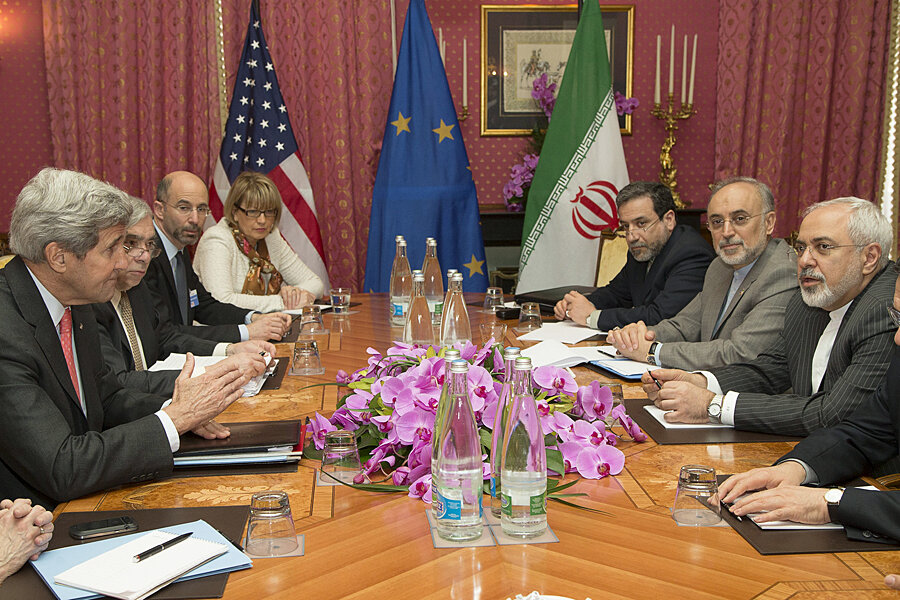Iran nuclear talks: Negotiations tough, but body language much improved
Loading...
| Lausanne, Switzerland
The scene would have been unthinkable even 18 months ago, when the first headline-grabbing contact in more than 30 years took place between the top diplomats of America and Iran.
But Friday in Lausanne, Switzerland, Secretary of State John Kerry and a high-level US delegation lined up like family members to offer somber condolences to Iranian delegation member Hossein Fereydoun, brother of President Hassan Rouhani, whose mother passed away in the morning.
Secretary Kerry was shown greeting the Iranian president’s brother with arms upraised, and later sitting nearby, extending his left hand to rest on Mr. Fereydoun’s arm. US Energy Secretary Ernest Moniz was at Kerry’s elbow. In one image, senior US negotiator Wendy Sherman held both her hands to her chest, while greeting the Iranian official.
The US and Iranian negotiators are in Lausanne for tough talks on curbing Iran’s nuclear program, facing an end-of-March deadline to find a “political framework” meant to lead to a comprehensive deal by the end of June.
But despite chronic challenges at the negotiating table, the body language Friday spoke of a personal familiarity that is one result of years of nuclear negotiations that have grown in intensity – and in diplomatic gravitas – since the mid-2013 election of Mr. Rouhani.
“It tells us that what was once impossible is now routine,” says Reza Marashi, a former State Department analyst, on how the condolences illustrate the transformation in high-level US-Iran contact after a generation of mutual hostility since the 1979 Islamic revolution.
“It demonstrates that the two sides have been humanized in one another’s eyes,” says Mr. Marashi, now research director at the Washington-based National Iranian American Council, which has advocated for a nuclear deal and against sanctions on Iran.
“Channels of communication have been established. They are not just talking about the nuclear program all the time; sometimes they talk about back pain, they talk about their families,” says Marashi. “They are actually human beings to one another, instead of ‘America’ and ‘Iran.’ And diplomacy is very personal, so that matters, in terms of trying to bridge the gaps [and] build common understandings.”
New Year wishes
In his first meeting Friday with his Iran counterpart, Kerry also offered “deepest condolences” to Iranian Foreign Minister Mohammad Javad Zarif, the American-educated diplomat whose ease with English and understanding of US and European politics has made the rounds of talks far more streamlined and cordial.
Kerry also noted that Friday night marks the start of Nowruz, the celebration of the New Year in Iran, and said, “we hope that this is a year that can bring us progress and peace.”
Mr. Zarif replied that “Nowruz” means “new day” in Farsi and said he hoped it would “be a new day for the entire world – a new era of greater understanding and peace.”
Outside the meeting room was a “haft sin” table, a Persian tradition, which has seven specific items beginning with the Farsi version of the letter “s” to usher in spring and the New Year. This table included a Quran, a goldfish, and growing green sprouts.
Ironically, Zarif has spent more time in direct discussions with Kerry than has any other foreign official. An indication of how frequent such contacts have been at many levels during these talks is the travel schedule of one US nuclear expert, who has crossed the Atlantic Ocean on 57 flights since early 2013.
Tough choices lie ahead
Diplomats ended this round of talks Friday, and are likely to resume them next Wednesday. Serious issues remain, especially about lifting UN Security Council resolutions against Iran, the speed and scale of lifting US and European sanctions, and the capacity of Iran’s continued nuclear research.
Divisions were also emerging between the US and France, which diplomats say is insisting on more stringent conditions on Iran.
President Barack Obama issued his own Nowruz video statement, an annual tradition for this White House. Focusing on the Iran talks, he said Iran should agree to a “reasonable deal.”
“This year, we have the best opportunity in decades to pursue a different future between our countries,” said Mr. Obama, who called on “Iranians and Americans to seize the moment.”
But he also said Iranian leaders had to make a choice, between isolation and more “hardship," or “greater opportunities.”
Zarif replied quickly on Twitter: “Iranians have already made their choice: Engage with dignity,” he wrote. “It’s high time for the US and its allies to chose [sic]: pressure or agreement.”








